How to clean decking – experts reveal the best ways to scrub your deck with and without a pressure washer
Clear the leaves and debris and get your decking ready for spring with our easy how-to
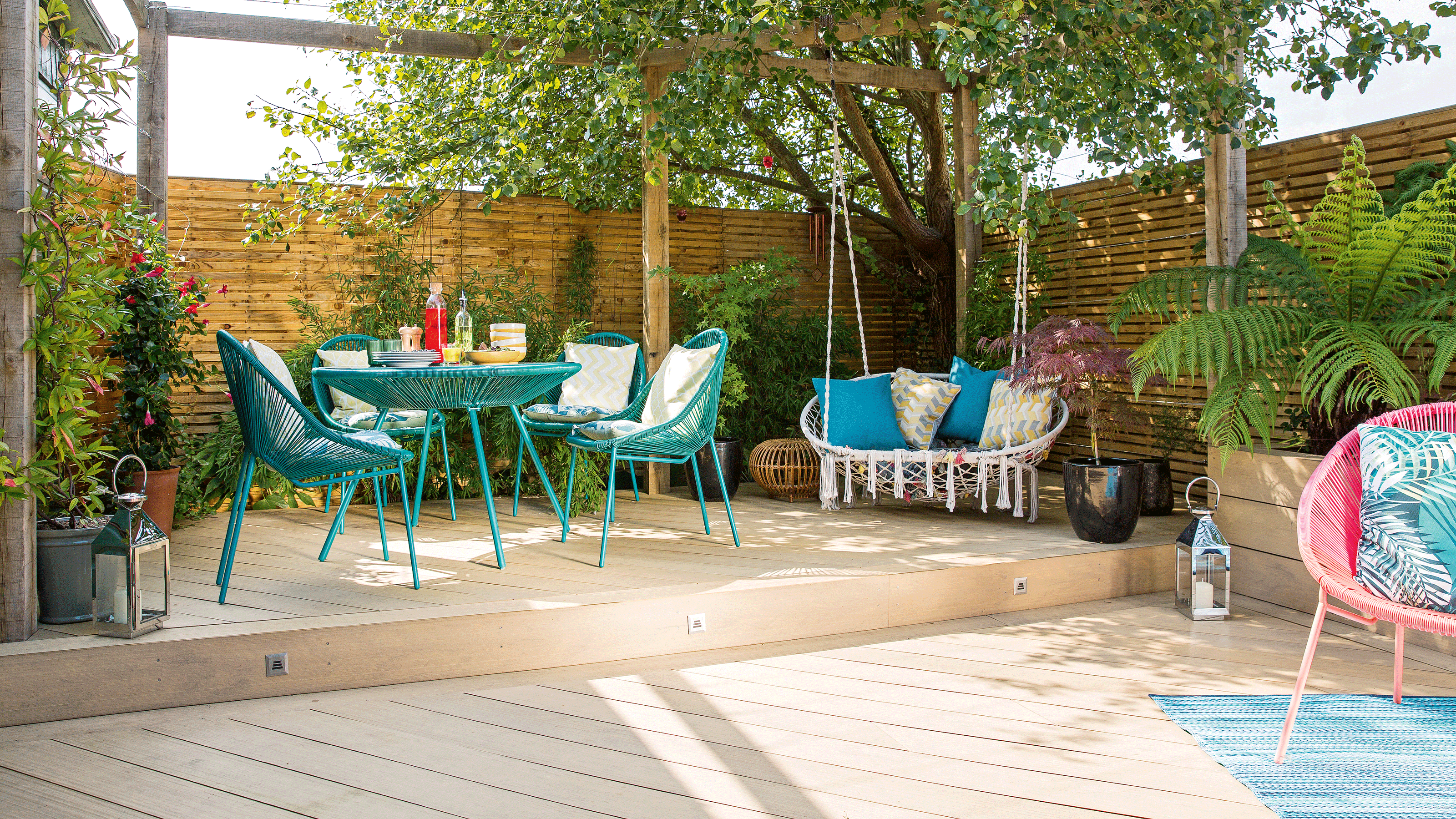

If you're lucky enough to have decking in your outdoor space, you'll want to keep it in tip-top condition so that it stays looking its best all year round. You can learn how to clean decking properly to get it looking as good as new again, even if it can sometimes feel like fighting a losing battle thanks to the adverse effects of the British weather.
The days are finally starting to lengthen and we've seen glimpses of the sun peeping from behind the clouds which means spring is just around the corner. And while your neighbours are probably out cleaning their patios, you'll soon be able to enjoy your garden decking idea again because now is the perfect time to transform it from weathered and tired to shiny and gleaming.
'Cleaning the decking isn’t a priority for many of us, however, it’s an easy fix that will give your garden a refresh,' says Jimmy Englezos, wood whizz and Senior Brand Manager at Ronseal. 'Not only will your decking look as good as new, but keeping it clean could help it to last longer too.'
So you can get your decking in perfect condition ahead of the spring garden parties and summer barbecues, we've asked the experts how to clean decking, with and without one of the best pressure washers, so you're covered either way. Plus the decking mistakes to avoid to make upkeep fuss-free.
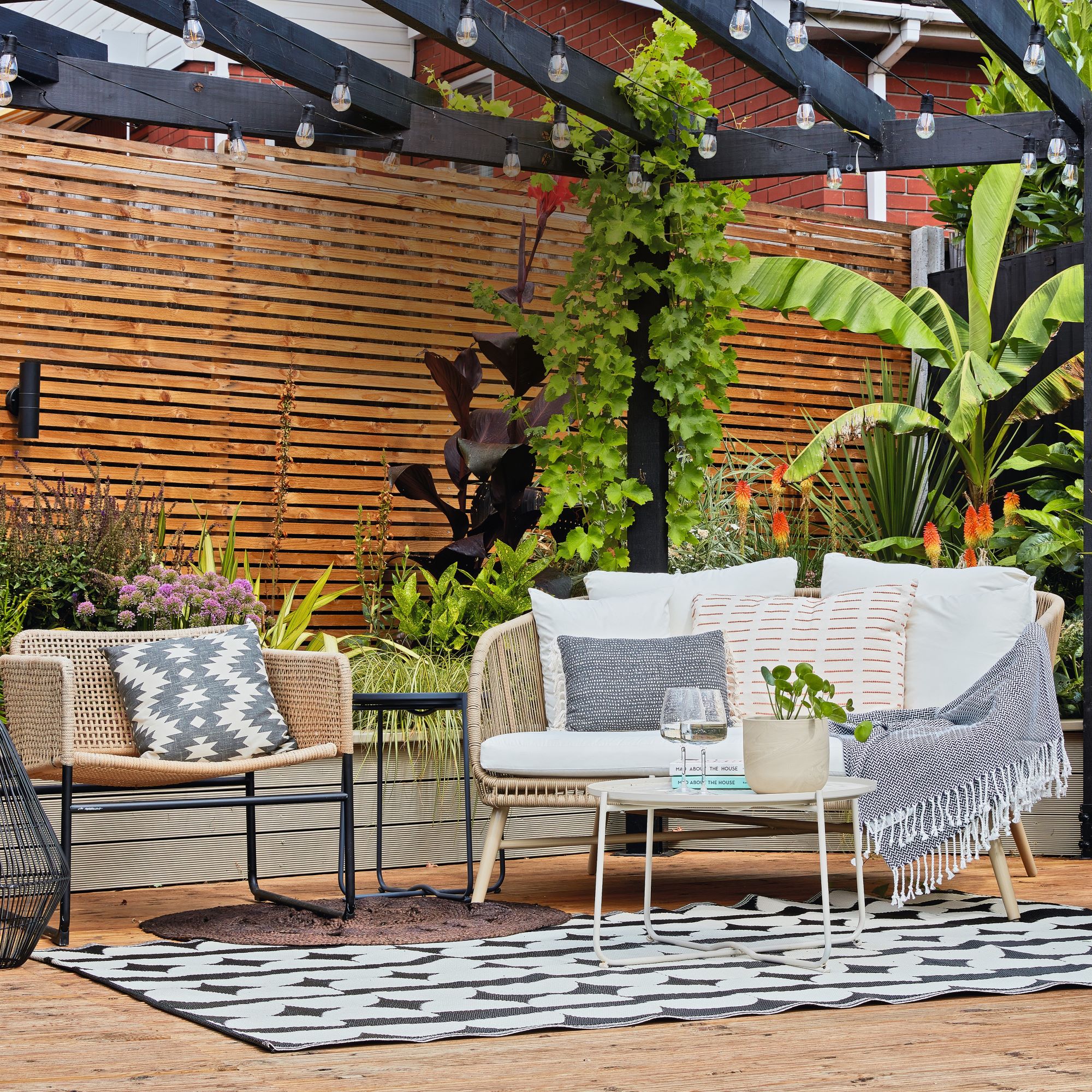
Unfortunately, decking can end up being slippery (and quite dangerous) if it’s not taken care of. Algae and moss can grow and form over the surface of the decking, making it difficult to walk on. You can stop the growth getting this bad with regular maintenance. But if it’s already set in don’t fear, as there’s plenty you can do to get it looking clean and new again.
Moss or algae aside, a garden deck, wooden or composite, needs a good clean now and then. And how to clean decking and deck railing ideas is actually really easy when you follow some simple steps; it doesn’t require lots of expensive products, either.
Before you get the brush out, it’s important to understand what your decking needs. For example, composite vs wood decking. Wooden decking, for example, requires a gentler approach than composite alternatives, as harsh chemicals and excessive scrubbing can damage the surface.
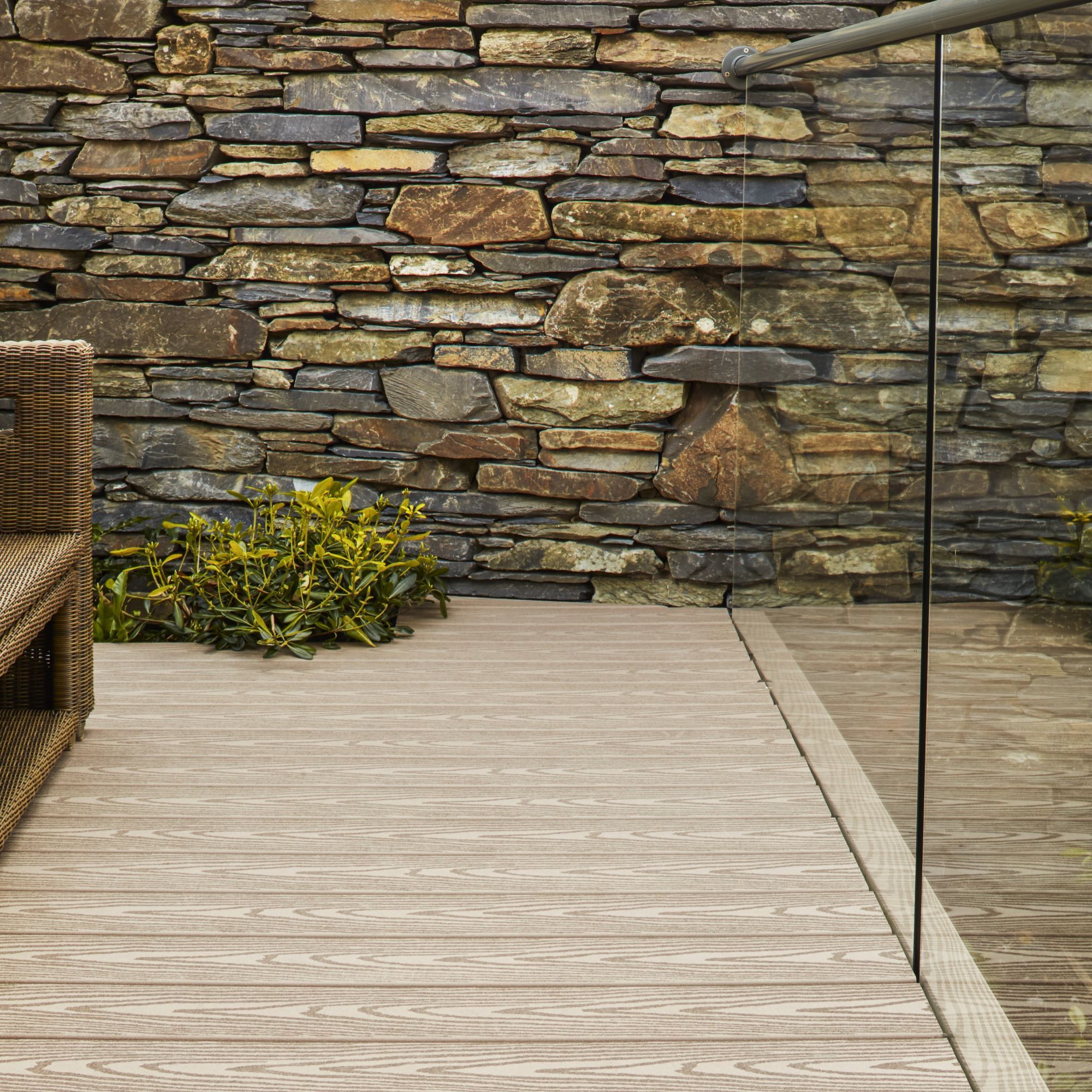
What you'll need
- A stiff brush - this Roughneck decking brush set available at Amazon will be handy for multiple outdoor cleaning jobs
- Washing up liquid: dependent on the size of deck, consider bulk buying Delphis eco friendly liquid at Amazon
- Hot water
- A specialist decking cleaner like Jeyes Patio and Decking Power which you can pick up at Amazon
- An anti-slip decking stain or oil: Cuprinol's anti-slip stain from Amazon is my favourite or go for V33's UV and water-resistant anti-slip decking oil
1. Get prepared to clean the decking
'First things first, take everything off your decking so it’s completely clear and ready for you to clean,' says Jimmy. 'Grab a broom and give your decking a good sweep to dislodge any dirt - don’t worry too much about any particularly problematic dirt for the moment.'
Remove everything that lives on the decking – furniture, pots, your barbecue, ornaments, and anything else. Pop them somewhere where they won’t be in the way for a day or so.
Whilst the weather is unpredictable, it’s best to work when the day is clear, and the deck is totally dry; allow a few days to pass since a downpour. Give the complete decking a thorough sweep, using a brush to get debris from between the cracks as best you can.
There's a smart Roughneck decking brush set available at Amazon that boasts a heavy-duty scrubbing brush with 6 rows of steel bristles. Then an angled brush to scrub away decking moss with a built-in scraper head with a steel hook to turf out tough weeds and moss from between grooves.
Jacksons Fencing's garden expert, Leigh Barnes adds, 'After cleaning, inspect for damage. Replace rotting or damaged boards, tighten loose screws/nails, and ensure railings are secure. This keeps the deck safe and structurally sound.'

2. Apply a cleaning solution
For a gentler clean to remove surface dirt and cobwebs, you can use a solution of washing up liquid in warm water. Be careful not to over-scrub with anything harshly abrasive, and avoid rubbing against the grain, as that can leave marks.
'Washing up liquid is commonly used to clean decking as it’s helpful in removing light stains and dirt without resulting in any damage,' explains Max Ledsham from Kingfisher Direct.
'If your decking is heavily stained then it’s best to use a stronger solution or specialist decking cleaning solution.'
Before you use the solution, Steven Walley, decking expert from London Stone advises you to prep the area first. He says: 'It’s important to clean your decking when it’s dry, so make sure it has fully dried out if it has been raining. Once ready, clear the area from any plant pots and use a broom to remove loose debris and leaves off the surface.'
Cleaning with vinegar is also safe for use on all types of decking. Mix a half cup of white vinegar with a gallon of water, then scrub the mixture on the decking with a cloth or brush.
'Vinegar is also safe to use on decking, as long as it is not undiluted,' suggests Steven. 'Mix half a cup of white vinegar with a gallon of water and pour onto your decking to soak for 5-10 minutes before using a cloth or bush to give it a scrub.'

Steven Walley is Managing Director of London Stone, one of the landscape industry’s leading paving suppliers.
He set up the company with his two brothers in 2006 after a career as a hard landscaper and is now a leading industry expert on hard landscaping and paving materials.
London Stone has ten showrooms and two depots, located nationwide.
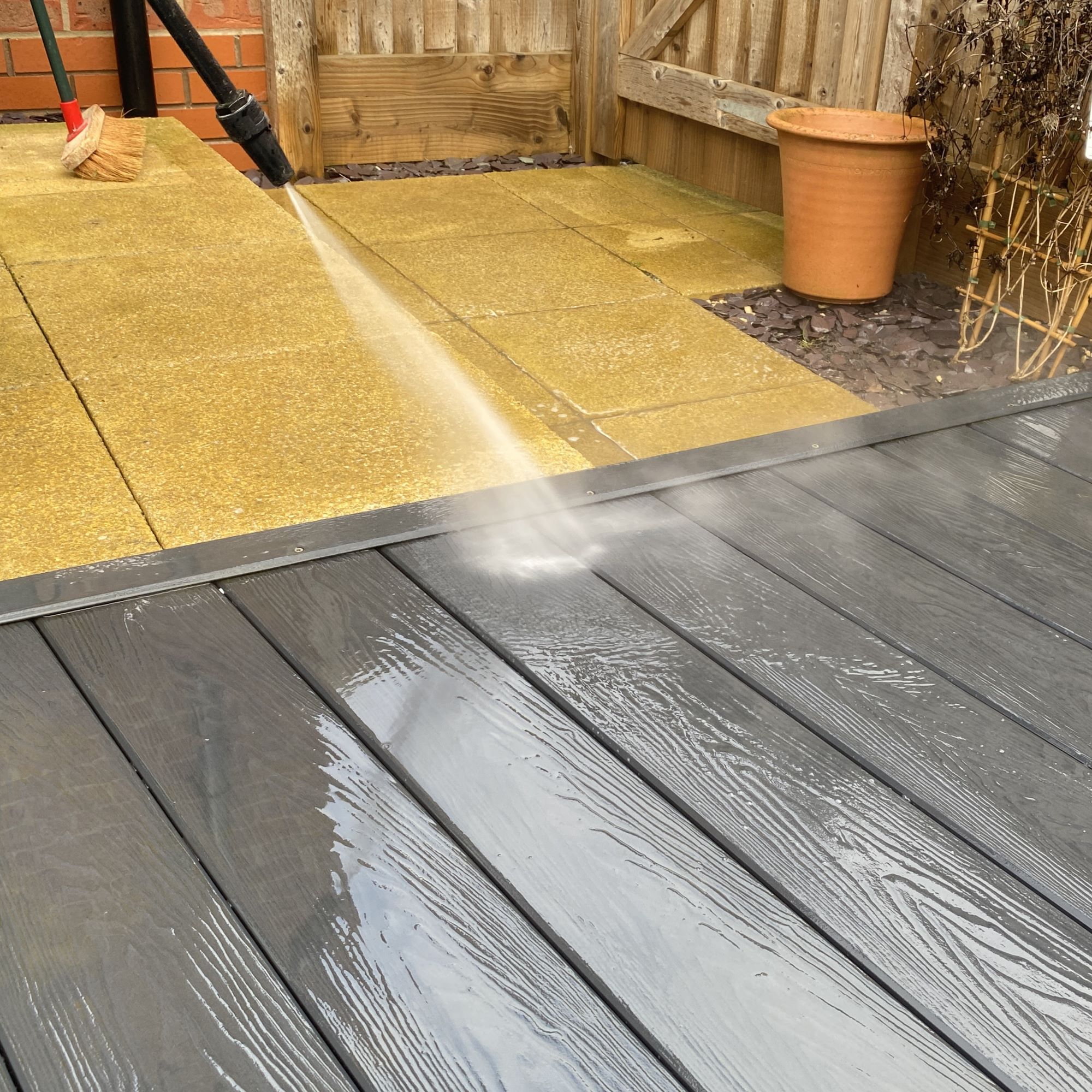
Alternatively, you can purchase a product made especially for cleaning decking. 'Whilst you can use soap water, a specialist product such as Jeyes Patio and Decking Power (which you can get at Amazon) is likely to be more effective to get rid of stubborn moss and algae,' says Sophie Herrmann, spokesperson for Jeyes Fluid. 'Mix it with water, pour it on and leave it to do its work.'
'Ronseal’s Decking Cleaner and Reviver (available at B&Q) preps new wood whilst cleaning up older decking. It can tackle algae and mould and can be used over stains and oils,' says Jimmy. 'The Decking Stripper(also at B&Q) is best used for those tough, stubborn stains that just won’t budge. It does exactly what it says on the tin and strips all stains and oils from your decking.'
Whatever product you're using, be sure to follow the manufacturer's instructions on how to apply, timings and how to rinse away.
3. Blast away grime with a pressure washer
A pressure washer is one thing that every gardener needs, and it will make learning how to clean decking much easier if you have one. If you don't want to invest in one just yet, you can still clean the decking with the cleaning solution on its own.
But if you've already got a pressure washer to hand, you'll want to get it ready if a lot of moss and algae has built up on the deck. 'Tackling your decking with a pressure washer will spray away any moss and grime that might have built up,' says Sophie Hermann. 'Ensure that the setting on the pressure washer is suitable for your decking, otherwise, it could potentially damage the surface.'
'Always use the low-pressure setting and make sure to start with a test patch in the corner of your decking so that if you need to make adjustments to the pressure, you can do so without damaging the main area of your decking.'
'Aim to keep the nozzle around 6 inches away from the surface and avoid changing the power settings throughout the cleaning process to avoid obvious marks,' advises Steven.
'Make sure to move in the same direction as the grain on the wood or composite deck, using a steady and consistent speed to create an even wash.'
While your decking can be cleaned with a pressure washer, Steven advises a gentler approach is best. So should you pressure wash decking?
'While a pressure washer can be a quick way to clean your decking, we always advise a gentler approach. This is because the strength of the water pressure can expose weaknesses in the wood, causing it to crack or splinter.'
'Using a pressure washer uses a lot more water too, making it longer for your decking to dry out,' adds Steven.
And when it comes to pressure washing a composite deck, Lee Heitzman, the UK & Ireland market manager for composite decking brand Trex explains, 'While you can use a pressure washer to clean composite decking, it must be on a setting no greater than 3100 psi and used with a fan attachment no closer than 20 centimetres from the decking surface. Rinse thoroughly to avoid any dirty water drying and leaving a film on the decking.'
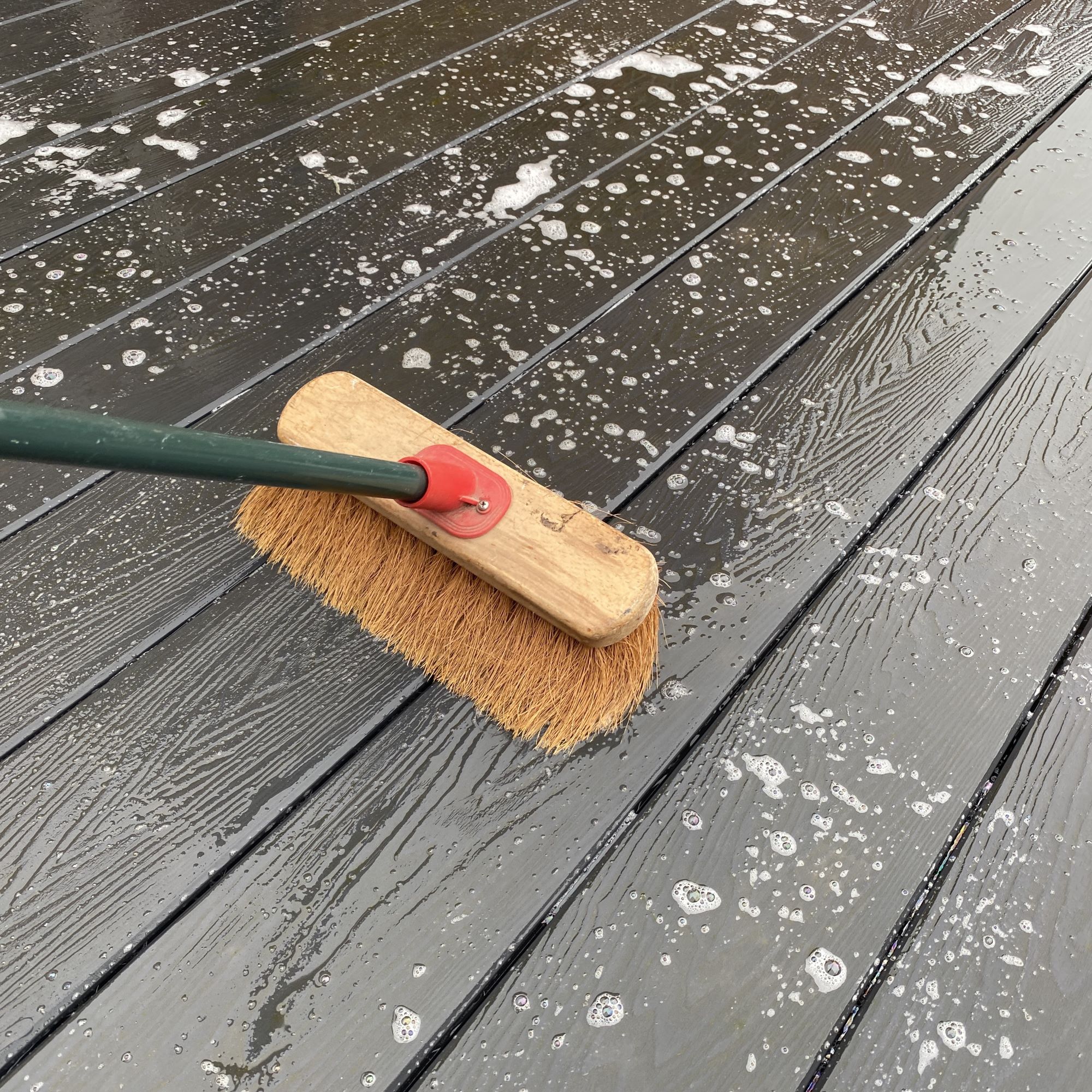
4. For an even deeper clean, use a stripper
If your decking is particularly dirty, then a more stringent cleaning may be required. In fact, this may be the case when preparing your decking for winter. Ronseal Decking Stripper which you can pick up on Amazon will leave your decking pristine.
'For this, you’ll need to wear some gloves and give the tin a shake before use,' says Jimmy Englezos, Senior Product Manager for Ronseal.
'Apply the stripper to your decking with a decent-sized brush – don’t be shy and ensure you apply a thick layer. It takes around 30 minutes to work,' explains Jimmy.
'However, if it’s a hot day you’ll need to keep an eye on patches that are drying out and re-apply a layer where needed. Keep scrubbing with warm water and then wash it all off with a hose, and you’re done!'
FAQs
How do I clean the decking without a pressure washer?
It's a good idea to learn how to wash decking without a pressure washer as well as with. A pressure washer isn't essential for getting a clean and sparkling deck, and in some cases, it can even risk damaging its surface.
'If you have a timber deck, the pressure washer may cause splintering or damage to the fibres,' says Fiona Jenkins, Gardening Expert, MyJobQuote. 'If the deck already has some splintering, you can further damage it with a pressure washer.'
Depending on the dirtiness of your decking and how much mould and mildew has formed, you could do just as good a job with washing liquid detergent. Pour four litres of warm water into a bucket and stir in 250ml of laundry detergent. Apply the warm solution liberally onto the already cleared and swept deck. Work it into the surface with a broom. Allow the solution to sit on the decking for ten to fifteen minutes and then rinse thoroughly using your garden hose.
You can also clean the decking with vinegar. 'Just make sure you do not use undiluted vinegar on your decking, and you also don’t want vinegar on your decking for long periods because, whilst it isn't as harsh as other chemicals, it still does contain acid,' says Allan Jeffrey, Managing Director, Ultra Decking.
Or you could try Cuprinol Decking Cleaner (you can pick it up on Amazon) which is a powerful detergent specifically formulated to remove dirt, grease, algae and mould.
How do I clean weathered decking?
'When it comes to cleaning weathered decking, you’ll want to take a gentle approach,' says Fiona.
Try cleaning weathered decking without a power washer first. Use a garden hose if you have one to wash away any dirt and grime, spraying in between the decks to dislodge any twigs and debris. Then clean the decking with a gentle cleaning solution made of warm water and soap.
'Saturate the surface of the deck and scrub with a sponge or stiff-bristled brush until the cleaning solution begins to lather,' Fiona says. 'Allow the solution to stand for around 5 – 10 minutes, then use your hose again to rinse away all of the cleaning solution.'
If your deck is really weathered, you can try staining the deck and then resealing it. 'Use a brush or small roller to coat the decking in sealant. Once the sealant is dry, look for any missed gaps or cracks', says Fiona. 'Fill these areas with caulk and then reseal these sections when the caulk is dried.'
How do I clean my deck without ruining it?
Gardening expert Fiona recommends using a garden hose rather than a pressure washer to clean the desk if you really don't want to risk causing any damage.
'Begin by brushing all of the debris from the deck and then wash it with the hose,' she says. 'For stubborn stains, use a sponge or stiff-bristled brush with a mixture of liquid dish salt and warm water. Scrub the stains with the mixture and leave it for around 5 – 10 minutes. Then, rinse away the solution with your hose.'
'Baking soda is also a good cleanser for decking without ruining it, as it’s not harsh enough to damage decking such as composite,' says Allan from Ultra Decking. 'When using baking soda to wash a composite board, sprinkle some baking soda on the decking. After sprinkling it on the decking surface, you can now scrub the decking with a soft bristle brush, and rinse with water.'
If the wood on your decking has started to rot, it's best to avoid using a pressure washer as this risks damaging it further.
How do I clean composite decking?
'Composite boards look, feel and are installed in the same way as natural wood, but they will not rot, splinter, warp or host algae growth - the latter of which means they are also highly anti-slip, even when wet,' says Roger Hemmings, Senior Marketing Project Development Manager, Havwoods. 'Composite boards are also extremely fade and stain resistant, making them essentially maintenance free, requiring no sanding, staining or painting.'
So the good news is that learning how to clean composite decking is usually easier than wooden decking. According to composite decking experts, NeoTimber, decking of this kind can actually be cleaned using general everyday household products. In most cases, a light soapy solution applied and then rinsed with a garden hose on a light setting is adequate for a composite deck.
'There aren’t any magic solutions or treatments that we’d recommend for treating your composite decking,' the NeoTimber experts say. 'In fact, with a bit of elbow grease, household cleaning items will be sure to do the trick and get your composite deck clean and tidy ready for the summer months.'
Start by clearing the deck of all items. Brush away any debris from nooks and crannies by giving the surface a thorough sweep. Next, mix a bucket of warm water with washing-up liquid to create a warm soapy solution. Apply directly onto the deck and clean with a soft bristled brush – a clean, dry broom will do the trick. Use a soft cloth or sponge in hard-to-reach areas, then rinse and allow to dry.
NeoTimber recommends a routine clean of your decking every three to six months to clear away dirt, mud and soil that can accumulate and sit on your composite decking over the course of time. For a deeper clean, you can use a pressure washer with no greater than 3100 PSI to clear surface debris from your deck. Using the fan attachment, ensure that this is not applied any closer than 250mm away from the surface of the boards. Following these tips will ensure you preserve the long-term finish of the decking.
'If you have a composite deck, your pressure washer may scar the deck boards if the pressure is too high,' says gardening expert Fiona. 'It may even chip the boards if the pressure becomes too intense. As long as you know what you're doing and you're careful with the pressure, a pressure washer won't damage your decking. However, it's important to test it in an inconspicuous area before getting to work to ensure the pressure levels are correct for your type of deck.'
How do I keep my decking looking good for longer?
Once you’ve spent the time cleaning, scrubbing and painting your decking, you’ll want to ensure it stays looking great for as long as possible. Whilst your decking will naturally take some general wear and tear from use, there are things you can do to limit damage.
'To minimise damage, we recommend using rubber feet for any deck furniture,' advice experts at Gripsure. 'In addition, any planters, tubs or plant pots should be raised on blocks to allow air circulation and avoid mould growth. We also recommend using metal or plastic trays to catch and retain any excess liquid when watering plants.'
For hot tub decking ideas consider the same principle, be mindful of water spills – perhaps seeking an underlay to protect the decking below.
Can I use household bleach to clean decking?
We asked Max Ledsham, from Kingfisher Direct for his view on using bleach on wood decking.
'Bleach can be good for removing tough stains and grime from decking as it can penetrate deep into the wood and kill mould or mildew,' explains Max.
'However, bleach can be a very corrosive solution so it’s best to only use it as a very last resort. Not only does bleach have the potential to damage your decking, but it can also bring harm to plants and wildlife in your garden. It’s likely that when rinsing your decking after cleaning, the excess bleach will transfer into other areas of your garden which can potentially kill plants or wildlife.'
The final flourish to perk up tired decking is to give it a lick of fresh paint or use a stain. You might like to leave the decking untreated, but a coating of a protective product will keep it looking fresh for longer. A layer of protection means it'll be able to withstand mould, algae and mildew.
'Once the decking is clean, applying the right decking oil will make sure it is water-repellent and UV-protected while also looking great for longer,' Richard Bradley, UK Head of Marketing at V33. 'This means money saved in the long run since failing to protect decking properly could result in having to replace it sooner.'
Ensure the decking is totally dry after cleaning, and brush away any leaves or debris that might’ve found its way there since cleaning.
You can find garden paint ideas and stains in a range of colours (Cuprinol's anti-slip stain from Amazon is my favourite) which will totally transform the decking. Or you could opt for a decking oil like V33's UV and water-resistant decking oil (available at Amazon) with extra anti-slip properties to boot.
If you're looking to get your paintbrush out, our guide to how to paint decking will help get a seamless finish.
Get the Ideal Home Newsletter
Sign up to our newsletter for style and decor inspiration, house makeovers, project advice and more.

Lizzie is an experienced and highly-regarded freelance writer and editor, specialising in interiors and women’s lifestyle. She has been producing inspiring content for print and digital platforms for over 15 years, having worked with some of the UK’s leading brands.
Most proudly, she is the former Editor for Style at Home, but has also held the reins for Grand Designs, Homemaker and House Beautiful during her exciting career.
- Katie SimsContributor
- Jenny McFarlaneSenior Digital Editor
You must confirm your public display name before commenting
Please logout and then login again, you will then be prompted to enter your display name.
-
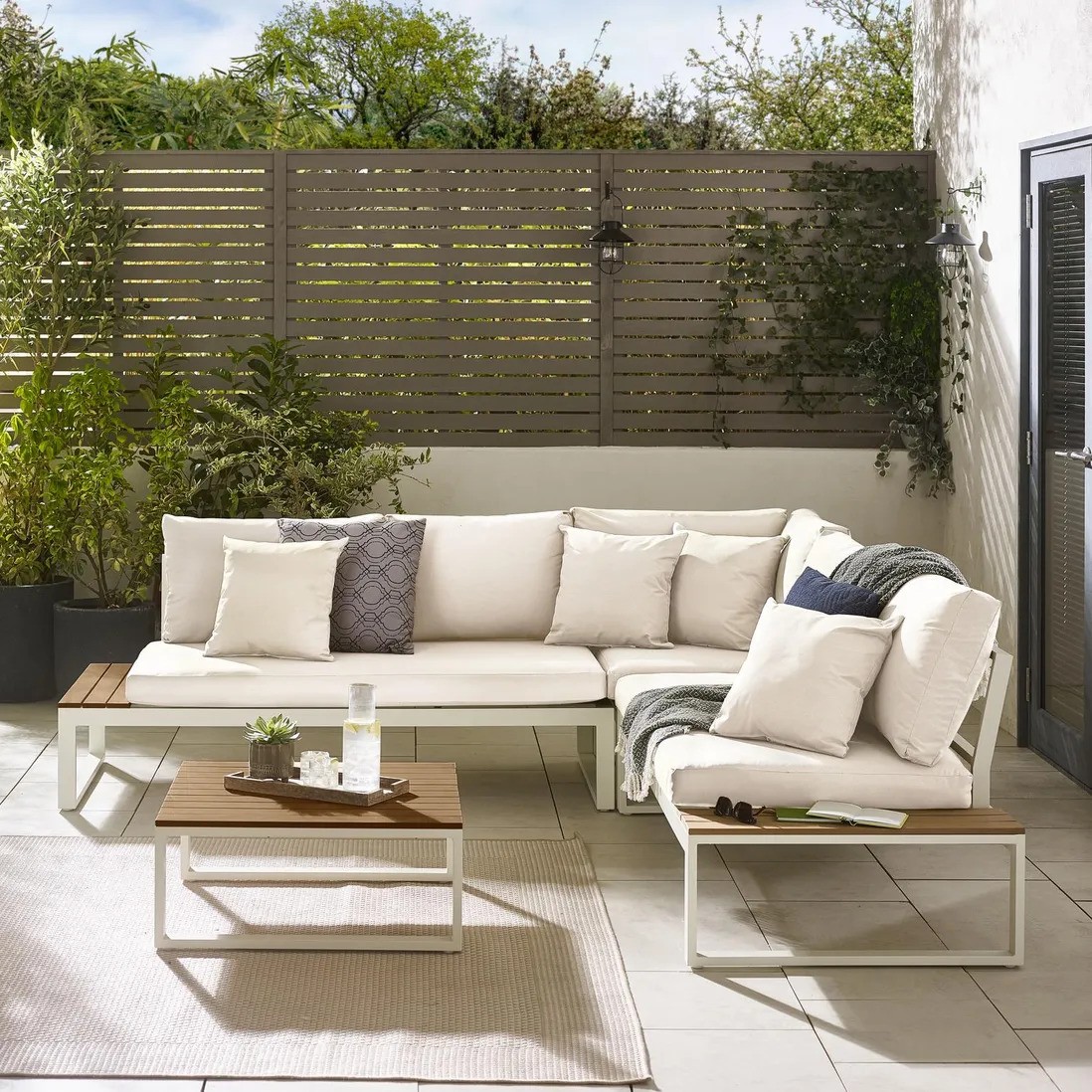 I'm a Homes Editor with expensive taste, but Debenhams just made me do a double-take with this bargain designer-look outdoor sofa
I'm a Homes Editor with expensive taste, but Debenhams just made me do a double-take with this bargain designer-look outdoor sofaThis is the last place I thought I'd find my dream outdoor sofa
By Rebecca Knight
-
 15 ways to add kerb appeal to your home – experts share what really works for a stylish first impression
15 ways to add kerb appeal to your home – experts share what really works for a stylish first impressionMake your home's exterior pop with these ideas
By Jenny McFarlane
-
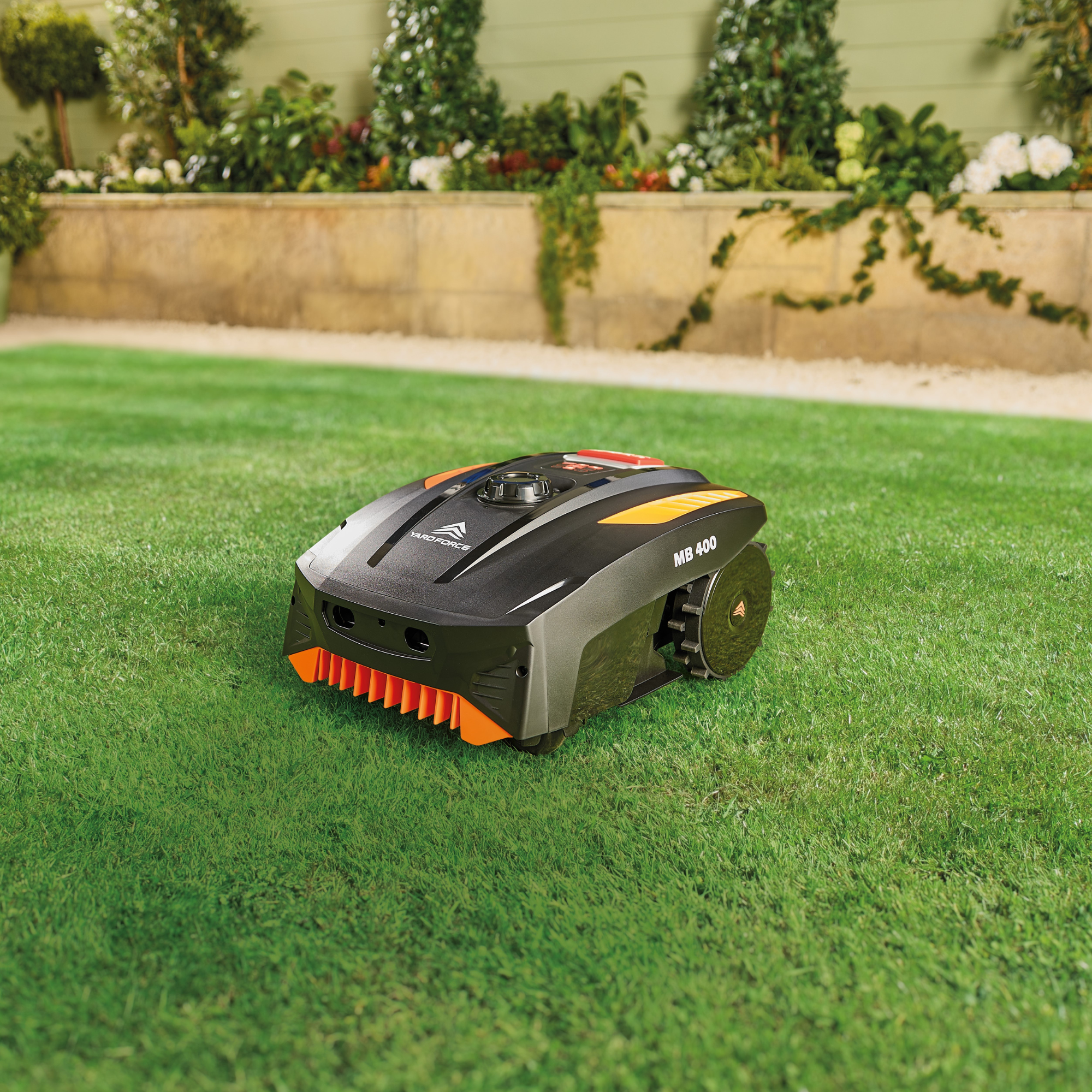 Aldi is selling a robot lawn mower for under £200 - it's one of the cheapest on the market
Aldi is selling a robot lawn mower for under £200 - it's one of the cheapest on the marketI never thought I'd see 'Aldi' and 'robot mower' in the same sentence...
By Kezia Reynolds